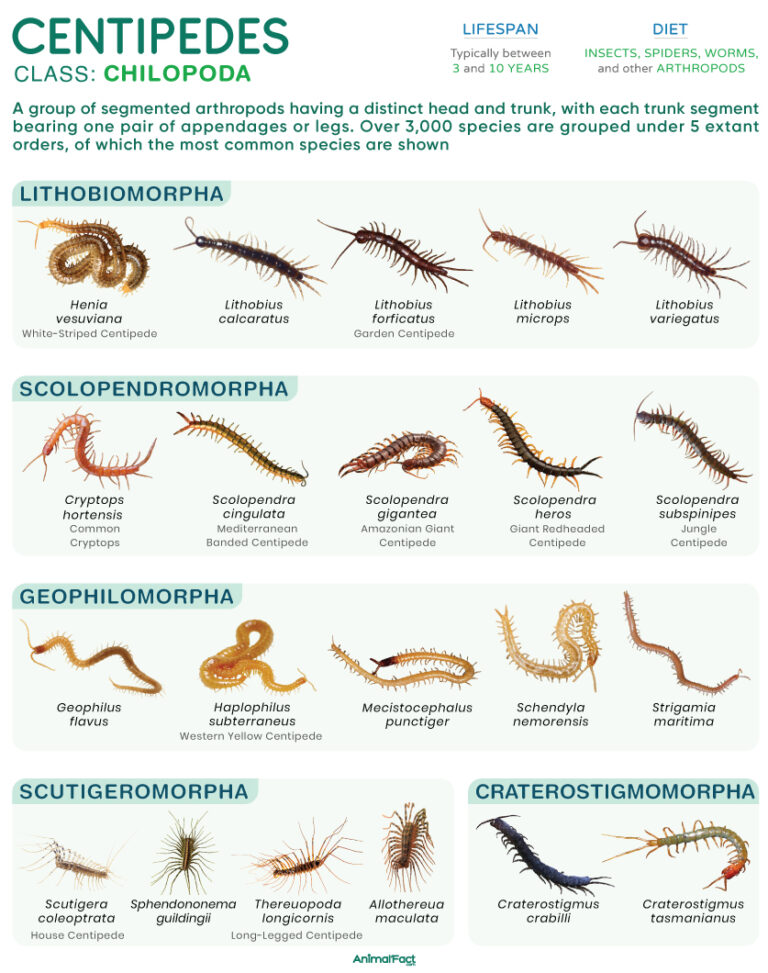


Centipedes are terrestrial arthropods belonging to the class Chilopoda within the subphylum Myriapoda. They have a segmented body with a distinct head and trunk, with each trunk segment bearing one pair of appendages or legs. These animals have a nearly worldwide distribution except in extremely cold regions.

Their name derives from the Neo-Latin word centi-, ‘hundred’, and the Latin word pedis, ‘foot’. Although their name literally translates to a hundred legs, the number of legs ranges from 15 pairs to over 190 pairs, depending on the species. The first pair of appendages is modified into pincer-like structures called forcipules, which help inject venom into the bodies of their prey.
The size of centipedes varies with species. For instance, the house-centipede (Scutigera coleoptrata) measures only about 1 in (25 mm), whereas the Amazonian giant centipede (Scolopendra gigantea), the largest species, is over 12 in (304 mm) long.[1]
These arthropods have a dorsoventrally flattened, segmented body, divided into two main regions or tagmata: the head and the trunk.
The head bears a pair of antennae and the mouthparts, comprising two pairs of maxillae and a pair of elongated mandibles.
At least 15 trunk segments follow the head, though a few species, such as Illacme plenipes, have over 300 segments.[2] The final segment, the telson, bears the openings of the reproductive organs.
Each body segment carries a single pair of appendages, unlike millipedes, which have two pairs on most segments. The first pair, forcipules or toxicognaths, is modified into pincer-like structures that deliver venom to subdue and immobilize prey. The final pair of legs, known as ultimate legs, may be elongated and thin, thickened, leaf-like, or pincer-like, depending on the species. The ultimate legs are used for defense, as well as for suspending from objects such as branches.
The legs gradually increase in length toward the rear of the body, helping prevent overlap and interference during movement. In some species, the ultimate legs can even be twice as long as the first.
Some species, such as the house centipede, have large, well-developed compound-like eyes with many ocelli, while others lack them altogether. However, these eyes only assist in light-dark detection and are incapable of forming clear images.
Members of most centipede orders possess a specialized paired sensory organ, the organ of Tömösváry (also known as temporal or postantennal organs), found at the base of the antennae, one on each side of the head. This organ most likely detects ground vibrations, helping the centipede sense prey or predators.
The name of the class, Chilopoda, derives from the Ancient Greek word kheilos (meaning lip) and the Neo-Latin suffix -poda (meaning foot), hinting at the forcipules in centipedes. Over 3,000 species are grouped under 5 extant orders.
The earliest fossils of this group, belonging to the genus Crussolum, date back to the Late Silurian Period (around 430 million years ago).
Centipedes are found on every continent except Antarctica. Since they lack a waxy cuticle, they are highly prone to desiccation and prefer microhabitats that are damp and cool.
These animals inhabit a wide range of habitats, from tropical rainforests and grasslands to caves and even deserts. They are found under stones, rotting logs, leaf litter, and bark, as well as within soil and dead wood. A few species, such as Strigamia maritima, are found in littoral environments.[3]
They are generalist predators that typically have a carnivorous diet comprising insects, spiders, worms, and other arthropods. Larger species, such as the Amazonian giant centipede, hunt vertebrates larger than themselves, including frogs, small snakes, lizards, birds, rodents, and even bats.[4][5]
A few species of Scolopendra, including S. cataracta, S. paradoxa, and S. alcyona, are amphibious and are believed to feed on aquatic invertebrates.
Although the lifespan of centipedes varies among different species, it tends to be longer than that of insects. For instance, the house centipede lives between 3 and 7 years, while the garden centipede (Lithobius forficatus) survives 5 to 6 years.[7][8] The species Scolopendra subspinipes is capable of surviving for over 10 years.[9]
Although most centipedes reproduce sexually, the reproductive process does not include copulation. The males produce small packets of sperm (spermatophores), which they deposit on the substrate for the females to collect. The female stores or immediately uses the sperm to fertilize her eggs internally. These fertilized eggs are deposited in soil, under stones, leaf litter, or in rotting wood. The mothers take care of the eggs by curling around them.
The eggs hatch as postembryos, which undergo several molts before attaining sexual maturity. Members of the orders Lithobiomorpha, Scutigeromorpha, and Craterostigmomorpha hatch with fewer segments and legs and gain more at each molt (anamorphic development). For instance, the house centipede hatches with 4 pairs of legs and attains 5, 7, 9, 11, 15, 15, 15, and 15 pairs through successive molts. In contrast, members of the orders Geophilomorpha and Scolopendromorpha possess the total number of legs at the time of hatching (epimorphic development).
They fall prey to various animals, including birds, mongooses, mice, salamanders, and beetles. A few predators specialize in centipedes. For example, the snake Cape centipede-eater (Aparallactus capensis) feeds exclusively on these arthropods. Similarly, Stigmatomma pluto, a species of African ant, feeds solely on soil centipedes.[10]